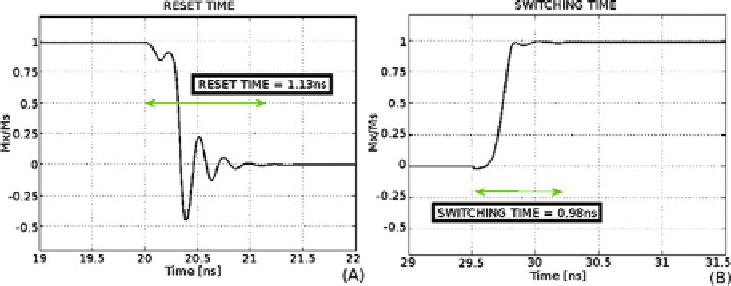Information Technology Reference
In-Depth Information
Fig. 15.
Magpar simulation of a NML wire. (A) Time required to successfully reset a
magnet. (B) Switching time, from RESET state to one of the two stable states.
frequency is 160 MHz. In case of a NAND gate with a width of 5 magnets,
N
is equal to 7, so the clock frequency is 125 MHz. Nonetheless, the evaluation of
the real clock frequency is more complex as different factors must be considered.
For example, the total switching time is not directly the sum of the switching
time of every magnet, because one magnet starts to switch before its neighbor
has completed the switching. The clock period is therefore lower and the fre-
quency higher. As a consequence the upper bound for the clock frequency can
be estimated in 200 MHz for gates with a width of 3 magnets and 150 MHz for
gates with a width of 5 magnets. Anyway this is just an upper bound as the real
clock frequency must be evaluated according to the multiphase clock scheme
selected, and it is consequently partially independent from the clock technology
itself. The clock frequency changes accordingly to the clock scheme selected, for
example with a 3 phase clock [
47
,
48
] the frequency will be lower than a 2 phase
clock [
17
]. For this reasons no further details are given on the clock frequency
value because out of the scope of this chapter.
Albeit timing is a crucial point, the most important parameter that must be
evaluated is the power consumption. Two contributions must be considered: The
intrinsic energy consumption required to force magnets in the reset state, and
the looses in the clock generation network. The intrinsic energy consumption is
equivalent to the height of the energy barrier between stable and reset states.
If an adiabatic switching is used, that means a very low rise time for the clock
signal, this value of energy consumption is reduced to 30
K
b
T
. In case, on the
contrary, an abrupt switching is used, that means a rise time for the clock signal
as short as possible, this value of energy consumption is equal to the entire energy
barrier. With magnetic field-based NML circuits, the value of energy barrier can
be very high (thousands of times
K
b
T
[
16
]) so there is a big difference between
adiabatic and abrupt switching. In this case with magnets of 50
10 nm
3
the energy barrier is just about 180
K
b
T
, so an abrupt switching is used, because
it allows to maximize performance.
×
65
×

Search WWH ::

Custom Search